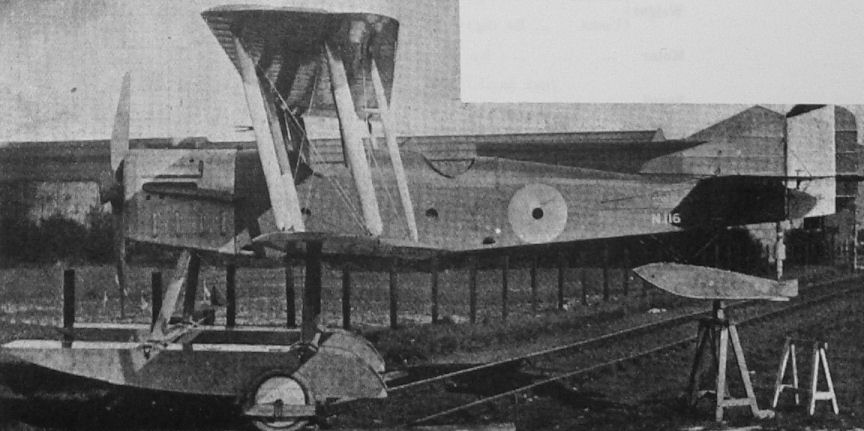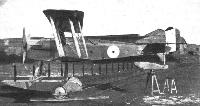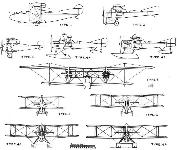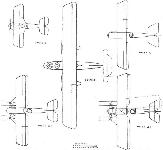J.Bruce British Aeroplanes 1914-1918 (Putnam)
Sage Types 4a, 4b, 4c
IN the summer of 1917 there appeared the Sage Type 4a, a two-seat float seaplane designed for patrol duties. The airframe differed very little from that of the Sage 3, and many components were identical.
The engine of the seaplane was the 150 h.p. Hispano-Suiza, which was fitted with twin stack-type exhausts; and single control only was provided in the forward cockpit.
The observer occupied the rear cockpit, in which a wireless installation was fitted. The floor of the rear cockpit was constructed to slide and give the observer a clear view directly downwards. The view from both cockpits was very good.� The Sage 4a made its first flight on July 3rd, 1917, and underwent official trials some time later. It was not accepted as a patrol seaplane, but was recommended for adoption as a training aircraft.
A considerable amount of re-designing had to be done to convert the machine into a trainer. Dual control was fitted, and the engine mounting was modified in order to take a variety of engines of 200 h.p. The trainer version of the design was re-designated Sage Type 4b, but the modifications occupied ten months and it did not fly until May 17th, 1918.
When the Sage 4b appeared, it was powered by a 200 h.p. Sunbeam Arab engine driving a four-bladed airscrew. In appearance it was conventional but considerably cleaner than most contemporary British seaplanes. Its basic structure consisted of the usual wire-braced wooden framework, but the machine was characterised by excellent detail design. The undercarriage consisted of two main floats of pontoon type, and a small tail-float which was fitted with a water rudder.
The Sage 4b underwent its official trials at the Isle of Grain.
A few months later, Sages produced a folding-wing version of the type under the designation Sage Type 4c. This was an almost completely new design, but looked very similar to the Sage 4b. It was a new aeroplane, bearing the serial number N.117.
The chief structural modification in the Sage 4c was the fitting of folding wings; but the wings themselves were new, and were of increased span and chord. Additional interplane struts were fitted at the inboard ends of the mainplanes in order to preserve the truss with the wings folded. The tail-unit was redesigned, as the areas quoted in the dimensional tables show, but the only noticeable change was the straight leading edge on the tailplane: all previous Sage types had had slight sweep-back on the tailplane leading edge.
The Sage 4c was fitted with a 200 h.p. Hispano-Suiza engine, driving a two-bladed airscrew. The main floats were somewhat larger than those of the Sage 4b. Further refinements in detail design were incorporated in the Sage 4c, and it would have been easy to produce and maintain. Provision was made for the fitting of a wheel undercarriage if necessary.
The Sage 4c first flew on October 12th, 1918, and underwent its official trials on October 25th. In the air it handled well. It was stable about all axes, yet was so manoeuvrable that normal aerobatics were within its capabilities. In November, 1918, the Sage 4c was used to test the application of the Gosport system of flying instruction to seaplanes.
Both the Sage 4b and 4c had been adopted as standard British training seaplanes for 1919, but the Armistice was signed before contracts could be placed, and no production was undertaken.
SPECIFICATION
Manufacturers: Frederick Sage & Co., Ltd., Peterborough.
Power: Sage 4a: 150 h.p. Hispano-Suiza. Sage 4b: 200 h.p. Sunbeam Arab. Sage 4c: 200 h.p. Hispano-Suiza.
Dimensions:
Aircraft Sage 4a Sage 4b Sage 4c
Span 34 ft 6 in. 34 ft 6 in. 39 ft 7J in.
Length 32 ft 6 in. 34 ft 37 ft 6 in.
Height 11 ft 3 in. - 11 ft 7 in.
Chord 4 ft 9 in. 4 ft 9 in. 5 ft 3 in.
Gap 5 ft 5 ft 3 in. 5 ft 3 in.
Stagger 11-8 in. 1 ft 2-7 in. 1 ft 4-7 in.
Dihedral 2° 30' 2° 30' 3°
Incidence: Upper 3° 3° 3° 10'
Lower 5° 5° 3° 10'
Span of tail 11 ft 4 in. - 11 ft
Airscrew diameter 9 ft - 9 ft
Areas (in sq ft):
Wings 330 330 386
Ailerons: Each 18 18 21
Total 72 72 84
Tailplane 26 26 24-4
Elevators 24 24 21-2
Fin 4 5 5-5
Rudder 10 9 8
Weights (lb) and Performance:
Aircraft Sage 4a Sage 4b Sage 4c
No. of Trial Report - - N.M.237
Date of Trial Report - - October 25th, 1918
Type of airscrew used on trial - - A.B.7202
Weight empty 1,620 - 2,215
Military load - - Nil
Crew - - 360
Fuel and oil - - 300
Weight loaded 2,662 2,709 2,875
Maximum speed (m.p.h.) at
sea level 83-5 95-5 -
3,000 ft - - 97-2
6,500 ft - - 96-6
10,000 ft 79 85-1 93-7
13,000 ft - - 83-1
m. s. m. s. m. s.
Climb to
1,000 ft - - - - 1 30
2,000 ft - - - - 3 00
3,000 ft - - - - 4 30
4,000 ft - - - - 6 00
5,000 ft 12 00 - - 8 00
6,000 ft - - - - 10 00
7,000 ft - - - - 12 15
8,000 ft - - - - 15 00
9,000 ft - - - - 17 50
10,000 ft 32 00 25 00 21 20
I 1,000 ft - - - - 25 30
12,000 ft - - - - 30 15
13,000 ft - - - - 36 50
Ceiling (feet): service - - 13,700
absolute 12,600 14,400 15,800
Endurance (hours) 4 2 1/2 2 1/2
Tankage: Petrol: Sage 4a, 48 gallons: Sage 4b and 4c, 35 1/2 gallons. Oil: Sage 4a, 6 gallons; Sage 4b and 4c, 4 1/2 gallons.
Service Use: No Sage seaplane saw operational service. The Sage 4b and 4c were tested at the Isle of Grain.
Production: One Sage 4a was built and later converted to the Sage 4b. One Sage 4c was built.
Serial Numbers: N. 116: Sage 4a, later 4b. N.117: Sage 4c.
H.King Armament of British Aircraft (Putnam)
Type 4. There were three versions of this successor to the Type 3, the first of which was a patrol seaplane. No armament appears to have been installed.
Jane's All The World Aircraft 1919
The Sage No. 4a was designed for sea patrol work in June 1917. It is similar to most float seaplanes and is fitted with a 150 h.p. Hispano-Suiza engine which gave the machine a considerably superior performance to any seaplane or flying boat of its power at the time. The No. 4b and No. 4c were similar to the No. 4a, but were fitted with dual control and 200 h.p. Hispano-Suiza and Sunbeam " Arab " engines. The No. 4c had staggered planes and folding gear, whilst the 46 had fixed wings of slightly smaller area and a faster wing section. Both types could be rolled, spun, looped, &c., and have been used for advanced training for seaplane pilots.
Specification.
Type of machine Seaplane.
Name or type No. of machine Sage 4a.
Purpose for which intended Patrol.
Span 84 ft 6 in.
Gap, maximum and minimum 5 ft.
Overall length 26 ft. 8 in.
Maximum height 11 ft. 3 in.
Chord 4 ft. 9 in.
Total surface of wings 330 sq. ft.
Span of tail 11 ft. 4 in.
Total area of tail 26 sq. ft.
Area of elevators 24 sq. ft.
Area of rudder 9 sq. ft.
Area of fin 7 sq. ft.
Area of each aileron 18 sq. ft.
Total area of ailerons 72 sq. ft.
Maximum cross section of body 2 ft. 6 In. x 2 ft. 5 In.
Horizontal area of body 59 sq. ft.
Vertical area of body 78 sq. ft.
Engine type and h.p. 150 h.p. Hispano.
Airscrew diameter and pitch 9 ft. d. x 7 ft. 3 In. p.
Airscrew revs. 1500 r.p.m.
Weight of machine empty 1620 lbs.
Load per sq. ft. 8.0 lbs.
Weight per h.p. 17.6 lbs.
Tank capacity in hours 4 hours.
Tank capacity in gallons 50 gallons.
Performance.
Speed low down 93 1/2 m.p.h.
Speed at 10.000 feet 81 m.p.h.
Landing speed 50 m.p.h.
Climb.
To 5.000 feet 12 minutes.
To 10,000 feet 25 minutes.
Disposable load apart from fuel 291 lbs.
Total weight of machine loaded 2645 lbs.
Ceiling 13,000ft.
SAGE 4B.
SAGE 4C.
Specification.
Type of machine Seaplane.
Name or type No. of machine Sage Seaplane.
Purpose for which intended Training.
Span 39 ft. 7 1/4 In.
Gap, maximum and minimum 5 ft. 3 in.
Overall length 37 ft. 6 In.
Maximum height 11 ft. 7 In.
Chord 5 ft. 3 In.
Total surface of wings 386 sq. ft.
Span of tail 11 ft.
Total area of tail 24 sq. ft.
Area of elevators 21 sq. ft.
Area of rudder 9 sq. ft.
Area of fin 7 sq. ft.
Area of each aileron 21 sq. ft.
Total area of ailerons 84 sq. ft.
Maximum cross section of body 2 ft. 6 in. x 2 ft. 5 In.
Horizontal area of body 56 sq. ft.
Vertical area of body 70 sq. ft.
Engine type and h.p. (4. A.) 200 h.p. Hispano-Suiza;
(4. B.) 200 h.p. "Arab" Sunbeam.
Airscrew diameter and pitch 9 ft. d. x 7 ft. 9 n. p.
Airscrew revs. 1500 r.p.m.
Weight of machine empty 2100 lbs.
Load per sq. ft. 7.45 lbs.
Weight per h.p. 14.4 lbs.
Tank capacity in hours 2 1/2 hours.
Tank capacity In gallons 35 gallons.
Performance.
Speed low down 97 m.p.h.
Speed at 10,000 feet 94 m.p.h.
Landing speed 45 m.p.h.
Climb.
To 5,000 feet 8 minutes.
To 10,000 feet 21 minutes.
Disposable load apart from fuel 155 lbs.
Total weight of machine loaded 2875 lbs.
Ceiling 15,800 ft.
Журнал Flight
Flight, July 24, 1919.
"MILESTONES"
THE SAGE MACHINES
The Sage Seaplanes (1917)
Following on Sage 3 came a seaplane, which was produced in July, 1917. This machine was designed for wireless work with the Fleet. In general lines it was very similar to Sage 3, but it was fitted with a 140 h.p. Hispano-Suiza engine instead of the 75 h.p. Rolls-Royce Hawk. Also it had single control, in the front cockpit, leaving the rear cockpit clear for the wireless installation and operator. The floor under the rear cockpit was made to slide out of the way so that the wireless operator could look straight down. As in the Type 3 a very good view was obtained from both cockpits, and the type was recommended for training purposes. This entailed the fitting of dual controls, while also the nose of the fuselage had to be modified to take either a Hispano-Suiza of a Sunbeam Arab engine. Consequently by the time this had been done the machine was a good deal different from the original, and it was given a different series number. While the original experimental machine was known as the Sage 4A, subsequent models were called 4B and 4c respectively. The latter two models were very similar in appearance, but whereas the 4B type had rigidly fixed wings, the 4c type was provided with folding wings. The increase in power, of from 140 h.p. to 200 h.p., naturally improved the performance, in spite of the additional weight of the engine and dual controls. The last machine turned out before the Armistice had a speed range of from 45 m.p.h. to 97 m.p.h., and climbed 10,000 ft. in 21 minutes.
The chief feature of all the Type 4 machines is the ease with which they can be stunted, and at the same time they are very stable, the pilot on one occasion leaving the machine to itself at 400 ft. and flying for a distance of about 50 miles.








